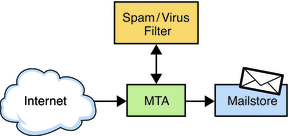Security Issues with Anti-Spam and Anti-Virus Deployments
When planning to deploy anti-spam or anti-virus technology, keep in mind that an incorrect deployment can defeat your security measures. Figure 14–1 shows an incorrect deployment of an anti-spam/anti-virus filter solution.
Figure 14–1 Incorrect Deployment of Anti-Spam/Virus Solution

Figure 14–2 shows a correct deployment of an anti-spam/virus filter solution.
Figure 14–2 Correct Deployment of Anti-Spam/Virus Solution

The MTA performs certain functions well, including:
-
Rejecting messages as early as possible
-
Per-user configuration and policy
-
Email security and routing policy
-
Mail queue management
The anti-spam/virus filter is good at determining if an email is spam or has a virus, but is generally not nearly as good at doing the things expected of a good MTA. Thus, do not depend on an anti-spam/virus filter to do those things. Your deployment is more “correct” when the anti-spam/virus filter is well integrated with the MTA, which is the case with Messaging Server. Messaging Server spam filter plug-in support provides all the potential reasons to reject a message early and applies all reasons at the same time.
A robust MTA, such as Messaging Server's, contains security features (SSL/TLS, traffic partitioning by IP address, early address rejection to reduce denial-of-service attacks, connection throttling by IP address/domain, and so on), which are defeated when an anti-spam/virus filter is deployed in front. Furthermore, anti-spam/virus filters that communicate by using the SMTP protocol often do not follow the robustness requirements of SMTP and thus lose email when they shouldn't. A correct deployment should have the anti-spam/virus filter working in conjunction with a robust MTA.
- © 2010, Oracle Corporation and/or its affiliates
